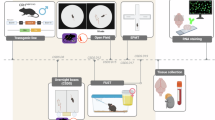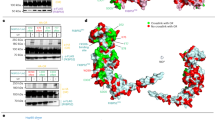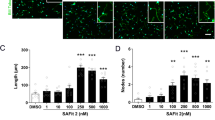Abstract
Various clinical studies have identified FK506-binding protein 51 (FKBP51) as a target gene involved in the development of psychiatric disorders such as depression. Furthermore, FKBP51 has been shown to affect glucocorticoid receptor signaling by sensitivity modulation and it is implicated in stress reactivity as well as in molecular mechanisms of stress vulnerability and resilience. We investigated the physiological, behavioral, and neuroendocrine parameters in an established chronic stress model both directly after stress and after a recovery period of 3 weeks and also studied the efficacy of paroxetine in this model. We then examined FKBP51 mRNA levels in the dorsal and ventral part of the hippocampus and correlated the expression to behavioral and endocrine parameters. We show robust chronic stress effects in physiological, behavioral, and neuroendocrine parameters, which were only slightly affected by paroxetine treatment. On the contrary, paroxetine led to a disruption of the neuroendocrine system. FKBP51 expression was significantly increased directly after the stress period and correlated with behavioral and neuroendocrine parameters. Taken together, we were able to further elucidate the role of FKBP51 in the mechanisms of stress resilience and vulnerability, especially with respect to behavioral and neuroendocrine parameters. These findings strongly support the concept of FKBP51 as a marker for glucocorticoid receptor sensitivity and its involvement in the development of psychiatric disorders.
Similar content being viewed by others
Log in or create a free account to read this content
Gain free access to this article, as well as selected content from this journal and more on nature.com
or
References
Bartolomucci A, Palanza P, Sacerdote P, Panerai AE, Sgoifo A, Dantzer R et al (2005). Social factors and individual vulnerability to chronic stress exposure. Neurosci Biobehav Rev 29: 67–81.
Berton O, McClung CA, Dileone RJ, Krishnan V, Renthal W, Russo SJ et al (2006). Essential role of BDNF in the mesolimbic dopamine pathway in social defeat stress. Science 311: 864–868.
Berton O, Nestler EJ (2006). New approaches to antidepressant drug discovery: beyond monoamines. Nat Rev Neurosci 7: 137–151.
Binder EB (2009). The role of FKBP5, a co-chaperone of the glucocorticoid receptor in the pathogenesis and therapy of affective and anxiety disorders. Psychoneuroendocrinology 34 (Suppl 1): S186–S195.
Binder EB, Salyakina D, Lichtner P, Wochnik GM, Ising M, Pütz B et al (2004). Polymorphisms in FKBP5 are associated with increased recurrence of depressive episodes and rapid response to antidepressant treatment. Nat Genet 36: 1319–1325.
Blokland A, Ten Oever S, van Gorp D, van Draanen M, Schmidt T, Nguyen E et al (2012). The use of a test battery assessing affective behavior in rats: order effects. Behav Brain Res 228: 16–21.
Burghardt NS, Sullivan GM, McEwen BS, Gorman JM, LeDoux JE (2004). The selective serotonin reuptake inhibitor citalopram increases fear after acute treatment but reduces fear with chronic treatment: a comparison with tianeptine. Biol Psychiatry 55: 1171–1178.
Carvalho LA, Pariante CM (2008). In vitro modulation of the glucocorticoid receptor by antidepressants. Stress 11: 411–424.
Choleris E, Thomas AW, Kavaliers M, Prato FS (2001). A detailed ethological analysis of the mouse open field test: effects of diazepam, chlordiazepoxide and an extremely low frequency pulsed magnetic field. Neurosci Biobehav Rev 25: 235–260.
Chourbaji S, Brandwein C, Vogt MA, Dormann C, Gass P (2008). Evaluation of effects of previous exposure to an acute stressor before testing for depression-like behaviours in mice. Stress 11: 170–175.
Chrousos GP (2009). Stress and disorders of the stress system. Nat Rev Endocrinol 5: 374–381.
de Kloet ER, Joëls M, Holsboer F (2005). Stress and the brain: from adaptation to disease. Nat Rev Neurosci 6: 463–475.
Gupta RK (2009). Major depression: an illness with objective physical signs. World J Biol Psychiatry 10: 196–201.
Hartmann J, Wagner KV, Liebl C, Scharf SH, Wang XD, Wolf M et al (2012). The involvement of FK506-binding protein 51 (FKBP5) in the behavioral and neuroendocrine effects of chronic social defeat stress. Neuropharmacology 62: 332–339.
Ising M, Depping AM, Siebertz A, Lucae S, Unschuld PG, Kloiber S et al (2008). Polymorphisms in the FKBP5 gene region modulate recovery from psychosocial stress in healthy controls. Eur J Neurosci 28: 389–398.
Krishnan V, Nestler EJ (2008). The molecular neurobiology of depression. Nature 455: 894–902.
Kurt M, Arik AC, Celik S (2000). The effects of sertraline and fluoxetine on anxiety in the elevated plus-maze test in mice. J Basic Clin Physiol Pharmacol 11: 173–180.
Linthorst ACE, Reul JM (2008). Stress and the brain: solving the puzzle using microdialysis. Pharmacol Biochem Behav 90: 163–173.
Malkesman O, Scattoni ML, Paredes D, Tragon T, Pearson B, Shaltiel G et al (2010). The female urine sniffing test: a novel approach for assessing reward-seeking behavior in rodents. Biol Psychiatry 67: 864–871.
McEwen BS (2004). Protection and damage from acute and chronic stress: allostasis and allostatic overload and relevance to the pathophysiology of psychiatric disorders. Ann NY Acad Sci 1032: 1–7.
McIlwain KL, Merriweather MY, Yuva-Paylor LA, Paylor R (2001). The use of behavioral test batteries: effects of training history. Physiol Behav 73: 705–717.
Menke A, Arloth J, Pütz B, Weber P, Klengel T, Mehta D et al (2012). Dexamethasone stimulated gene expression in peripheral blood is a sensitive marker for glucocorticoid receptor resistance in depressed patients. Neuropsychopharmacology 37: 1455–1464.
Mizoguchi K, Ishige A, Aburada M, Tabira T (2003). Chronic stress attenuates glucocorticoid negative feedback: involvement of the prefrontal cortex and hippocampus. Neuroscience 119: 887–897.
Norcross M, Mathur P, Poonam M, Enoch AJ, Karlsson RM, Brigman JL et al (2008). Effects of adolescent fluoxetine treatment on fear-, anxiety- or stress-related behaviors in C57BL/6J or BALB/cJ mice. Psychopharmacology (Berl) 200: 413–424.
Pariante CM, Miller AH (2001). Glucocorticoid receptors in major depression: relevance to pathophysiology and treatment. Biol Psychiatry 49: 391–404.
Pariante CM, Thomas SA, Lovestone S, Makoff A, Kerwin RW (2004). Do antidepressants regulate how cortisol affects the brain? Psychoneuroendocrinology 29: 423–447.
Petit-Demouliere B, Chenu F, Bourin M (2005). Forced swimming test in mice: a review of antidepressant activity. Psychopharmacology (Berl) 177: 245–255.
Pratt WB, Morishima Y, Murphy M, Harrell M (2006). Chaperoning of glucocorticoid receptors. Handb Exp Pharmacol 172: 111–138.
Reul JM, Stec I, Söder M, Holsboer F (1993). Chronic treatment of rats with the antidepressant amitriptyline attenuates the activity of the hypothalamic-pituitary-adrenocortical system. Endocrinology 133: 312–320.
Roy A, Hodgkinson CA, Deluca V, Goldman D, Enoch MA (2012). Two HPA axis genes, CRHBP and FKBP5, interact with childhood trauma to increase the risk for suicidal behavior. J Psychiatr Res 46: 72–79.
Rush AJ, Trivedi MH, Wisniewski SR, Nierenberg AA, Stewart JW, Warden D et al (2006). Acute and longer-term outcomes in depressed outpatients requiring one or several treatment steps: a STAR*D report. Am J Psychiatry 163: 1905–1917.
Sarapas C, Cai G, Bierer LM, Golier JA, Galea S, Ising M et al (2011). Genetic markers for PTSD risk and resilience among survivors of the World Trade Center attacks. Dis Markers 30: 101–110.
Savignac HM, Finger BC, Pizzo RC, O′Leary OF, Dinan TG, Cryan JF (2011). Increased sensitivity to the effects of chronic social defeat stress in an innately anxious mouse strain. Neuroscience 192: 524–536.
Scharf SH, Liebl C, Binder EB, Schmidt MV, Müller MB (2011). Expression and regulation of the Fkbp5 gene in the adult mouse brain. PloS One 6: e16883.
Schmidt MV, Sterlemann V, Ganea K, Liebl C, Alam S, Harbich D et al (2007). Persistent neuroendocrine and behavioral effects of a novel, etiologically relevant mouse paradigm for chronic social stress during adolescence. Psychoneuroendocrinology 32: 417–429.
Schmidt MV, Trümbach D, Weber P, Wagner K, Scharf SH, Liebl C et al (2010). Individual stress vulnerability is predicted by short-term memory and AMPA receptor subunit ratio in the hippocampus. J Neurosci 30: 16949–16958.
Sillaber I, Panhuysen M, Henniger MSH, Ohl F, Kühne C, Pütz B et al (2008). Profiling of behavioral changes and hippocampal gene expression in mice chronically treated with the SSRI paroxetine. Psychopharmacology (Berl) 200: 557–572.
Tennant C (2001). Work-related stress and depressive disorders. J Psychosom Res 51: 697–704.
Thase ME (2006). Preventing relapse and recurrence of depression: a brief review of therapeutic options. CNS Spectr 11: 12–21.
Thoeringer CK, Erhardt A, Sillaber I, Müller MB, Ohl F, Holsboer F et al (2010). Long-term anxiolytic and antidepressant-like behavioural effects of tiagabine, a selective GABA transporter-1 (GAT-1) inhibitor, coincide with a decrease in HPA system activity in C57BL/6 mice. J Psychopharmacol (Oxford) 24: 733–743.
Touma C, Gassen NC, Herrmann L, Cheung-Flynn J, Büll DR, Ionescu IA et al (2011). FK506 binding protein 5 shapes stress responsiveness: modulation of neuroendocrine reactivity and coping behavior. Biol Psychiatry 70: 928–936.
Tsankova NM, Berton O, Renthal W, Kumar A, Neve RL, Nestler EJ (2006). Sustained hippocampal chromatin regulation in a mouse model of depression and antidepressant action. Nat Neurosci 9: 519–525.
Ulrich-Lai YM, Herman JP (2009). Neural regulation of endocrine and autonomic stress responses. Nat Rev Neurosci 10: 397–409.
Venzala E, García-García L, Elizalde N, Delagrange P, Tordera RM (2012). Chronic social defeat stress model: behavioral features, antidepressant action, and interaction with biological risk factors. Psychopharmacology (Berl); e-pub ahead of print, doi:10.1007/s00213-012-2754-5.
Vermeer H, Hendriks-Stegeman BI, van der Burg B, van Buul-Offers SC, Jansen M (2003). Glucocorticoid-induced increase in lymphocytic FKBP51 messenger ribonucleic acid expression: a potential marker for glucocorticoid sensitivity, potency, and bioavailability. J Clin Endocrinol Metab 88: 277–284.
Wagner KV, Wang XD, Liebl C, Scharf SH, Müller MB, Schmidt MV (2011). Pituitary glucocorticoid receptor deletion reduces vulnerability to chronic stress. Psychoneuroendocrinology 36: 579–587.
Wang JC, Derynck MK, Nonaka DF, Khodabakhsh DB, Haqq C, Yamamoto KR (2004). Chromatin immunoprecipitation (ChIP) scanning identifies primary glucocorticoid receptor target genes. Proc Natl Acad Sci USA 101: 15603–15608.
Wang XD, Chen Y, Wolf M, Wagner KV, Liebl C, Scharf SH et al (2011). Forebrain CRHR1 deficiency attenuates chronic stress-induced cognitive deficits and dendritic remodeling. Neurobiol Dis 42: 300–310.
Wochnik GM, Rüegg J, Abel GA, Schmidt U, Holsboer F, Rein T (2005). FK506-binding proteins 51 and 52 differentially regulate dynein interaction and nuclear translocation of the glucocorticoid receptor in mammalian cells. J Biol Chem 280: 4609–4616.
Wulsin AC, Herman JP, Solomon MB (2010). Mifepristone decreases depression-like behavior and modulates neuroendocrine and central hypothalamic-pituitary-adrenocortical axis responsiveness to stress. Psychoneuroendocrinology 35: 1100–1112.
Zimmermann P, Brückl T, Nocon A, Pfister H, Binder EB, Uhr M et al (2011). Interaction of FKBP5 gene variants and adverse life events in predicting depression onset: results from a 10-year prospective community study. Am J Psychiatry 168: 1107–1116.
Acknowledgements
We thank Daniela Harbich and Bianca Schmid for their excellent technical support as well as Alexander Yassouridis for his expertise on all statistical matters. We also thank Elisabeth Binder for proof reading the manuscript. This study was supported by the Max Planck Society.
Author information
Authors and Affiliations
Corresponding author
Ethics declarations
Competing interests
Florian Holsboer is a co-inventor of the following pending patent application: FKBP5: a novel target for antidepressant therapy (International publication number: WO 2005/05450). The other authors declare no conflict of interest.
Additional information
Supplementary Information accompanies the paper on the Neuropsychopharmacology website
Supplementary information
Rights and permissions
About this article
Cite this article
Wagner, K., Marinescu, D., Hartmann, J. et al. Differences in FKBP51 Regulation Following Chronic Social Defeat Stress Correlate with Individual Stress Sensitivity: Influence of Paroxetine Treatment. Neuropsychopharmacol 37, 2797–2808 (2012). https://doi.org/10.1038/npp.2012.150
Received:
Revised:
Accepted:
Published:
Issue date:
DOI: https://doi.org/10.1038/npp.2012.150
Keywords
This article is cited by
-
Effects of antidepressant on FKBP51 mRNA expression and neuroendocrine hormones in patients with panic disorder
BMC Psychiatry (2024)
-
Automatically annotated motion tracking identifies a distinct social behavioral profile following chronic social defeat stress
Nature Communications (2023)
-
Social defeat drives hyperexcitation of the piriform cortex to induce learning and memory impairment but not mood-related disorders in mice
Translational Psychiatry (2022)
-
FKBP51 modulates hippocampal size and function in post-translational regulation of Parkin
Cellular and Molecular Life Sciences (2022)
-
The co-chaperone Fkbp5 shapes the acute stress response in the paraventricular nucleus of the hypothalamus of male mice
Molecular Psychiatry (2021)



